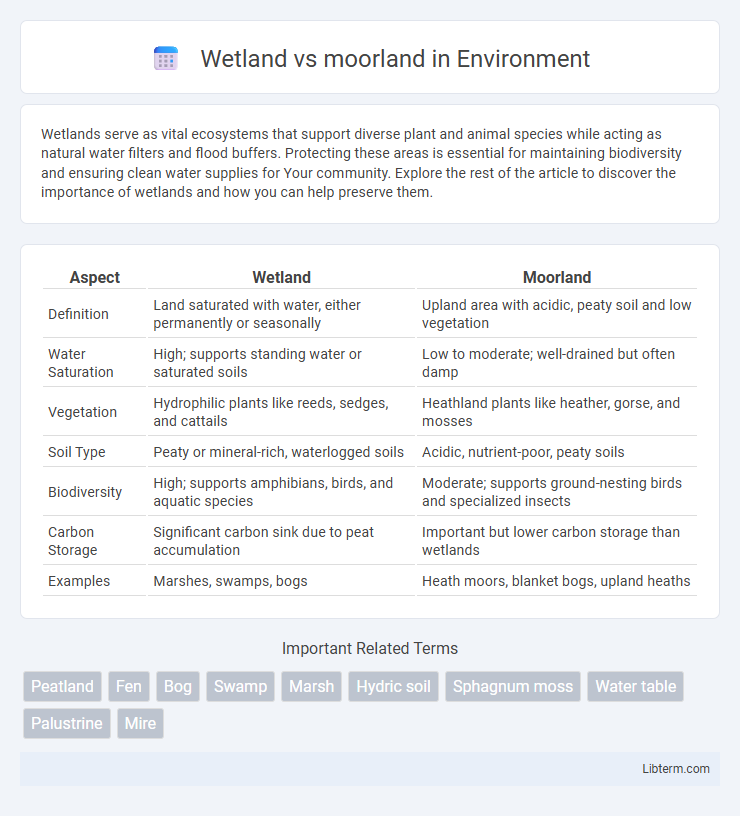Wetlands serve as vital ecosystems that support diverse plant and animal species while acting as natural water filters and flood buffers. Protecting these areas is essential for maintaining biodiversity and ensuring clean water supplies for Your community. Explore the rest of the article to discover the importance of wetlands and how you can help preserve them.
Table of Comparison
| Aspect | Wetland | Moorland |
|---|---|---|
| Definition | Land saturated with water, either permanently or seasonally | Upland area with acidic, peaty soil and low vegetation |
| Water Saturation | High; supports standing water or saturated soils | Low to moderate; well-drained but often damp |
| Vegetation | Hydrophilic plants like reeds, sedges, and cattails | Heathland plants like heather, gorse, and mosses |
| Soil Type | Peaty or mineral-rich, waterlogged soils | Acidic, nutrient-poor, peaty soils |
| Biodiversity | High; supports amphibians, birds, and aquatic species | Moderate; supports ground-nesting birds and specialized insects |
| Carbon Storage | Significant carbon sink due to peat accumulation | Important but lower carbon storage than wetlands |
| Examples | Marshes, swamps, bogs | Heath moors, blanket bogs, upland heaths |
Introduction to Wetlands and Moorlands
Wetlands are ecosystems characterized by water-saturated soils, supporting diverse plant species such as reeds, sedges, and water-tolerant trees, and play a crucial role in water purification, flood control, and habitat provision. Moorlands are upland habitats dominated by heather, grasses, and peat-forming plants, often found on acidic, nutrient-poor soils with a cooler climate, supporting unique wildlife adapted to open, exposed conditions. Both wetlands and moorlands contribute significantly to biodiversity and carbon sequestration, but differ primarily in hydrology, vegetation, and ecological functions.
Defining Wetlands: Key Characteristics
Wetlands are ecosystems where water saturation predominates soil conditions, supporting hydrophytic vegetation and unique biodiversity adapted to saturated environments. Key characteristics include standing or slow-moving water, anaerobic soil layers, and specialized plant species like reeds, sedges, and water lilies. Unlike moorlands, wetlands function as natural water filters and carbon sinks, playing a critical role in flood control and ecosystem stability.
What Makes a Moorland? Essential Features
Moorlands are characterized by acidic, nutrient-poor soils and a dominance of heather, grasses, and mosses, thriving in cool, wet climates often found at higher altitudes. They support unique biodiversity, including specialized bird species such as red grouse and plants adapted to low fertility environments. Unlike wetlands, moorlands do not have standing water but maintain moisture through peat and organic matter accumulation in well-drained, yet damp, soil conditions.
Geographical Distribution of Wetlands and Moorlands
Wetlands are predominantly found in regions with abundant water sources such as river deltas, coastal areas, and floodplains in North America, Southeast Asia, and the Amazon Basin. Moorlands are typically located in upland areas with acidic, nutrient-poor soils, commonly spread across the British Isles, northern Europe, and parts of Scandinavia. The distribution of wetlands is influenced by hydrological conditions, whereas moorlands are shaped by climate and soil types favoring heathland vegetation.
Biodiversity and Ecosystem Services
Wetlands support high biodiversity by providing critical habitats for numerous species, including amphibians, birds, and aquatic plants, and they play essential roles in water filtration and flood control. Moorlands, characterized by acidic soils and heather vegetation, sustain unique flora and fauna adapted to nutrient-poor conditions, contributing to carbon sequestration and soil conservation. Both ecosystems offer vital carbon storage but differ in hydrology, with wetlands relying on saturated soils and moorlands on well-drained, acidic substrates.
Climate and Hydrological Differences
Wetlands are characterized by saturated soils and standing water that create unique hydrological conditions supporting diverse aquatic ecosystems, while moorlands have well-drained, acidic soils with limited water retention leading to drier habitats. Climate in wetlands features higher humidity and consistent water availability, promoting peat accumulation and diverse plant species adapted to waterlogged environments. Moorlands typically experience cooler temperatures and more variable precipitation, affecting soil moisture and supporting heathland vegetation adapted to poorer nutrient conditions.
Plant and Animal Life: Wetland vs Moorland
Wetlands host a diverse array of water-loving plants such as reeds, sedges, and water lilies, supporting amphibians, waterfowl, and insects adapted to saturated soils. Moorlands are dominated by heather, gorse, and grasses, providing habitat for ground-nesting birds like grouse and specialized mammals such as mountain hares. The distinct hydrology and soil conditions drive these unique ecosystems, resulting in varied biodiversity profiles between wetland and moorland environments.
Human Impact and Conservation Efforts
Wetlands face significant threats from urban development, pollution, and drainage for agriculture, resulting in habitat loss and reduced biodiversity, while moorlands are primarily impacted by overgrazing, peat extraction, and wildfire occurrences. Conservation efforts for wetlands emphasize water quality improvement, restoration of natural hydrology, and protection of critical habitats through regulatory policies and wetland buffers. In moorlands, restoration initiatives focus on re-vegetation, controlled grazing, peatland re-wetting, and fire management to maintain carbon storage and support native species.
Environmental Benefits and Challenges
Wetlands provide crucial environmental benefits such as water filtration, carbon sequestration, and habitat for diverse wildlife, while moorlands support unique biodiversity and act as significant carbon sinks through peat accumulation. Wetlands face challenges like pollution, drainage, and habitat loss from urbanization and agriculture, whereas moorlands are threatened by overgrazing, burning practices, and climate change impacts affecting peat degradation. Effective conservation of both ecosystems enhances biodiversity, regulates water cycles, and helps mitigate climate change effects.
Deciding Between Wetland and Moorland Restoration
Choosing between wetland and moorland restoration depends on factors such as soil type, hydrology, and biodiversity goals. Wetlands offer high carbon sequestration and support diverse aquatic species, while moorlands promote peat formation and provide habitat for upland birds. Understanding local ecosystem services and long-term climate benefits guides effective restoration strategies.
Wetland Infographic

 libterm.com
libterm.com